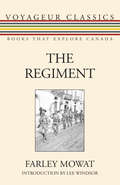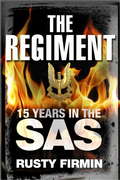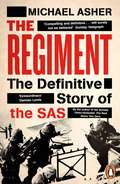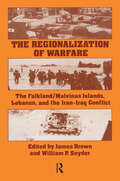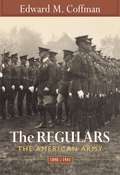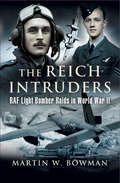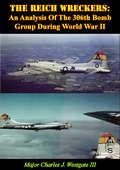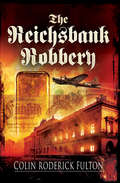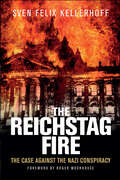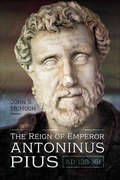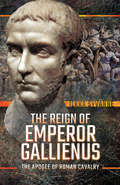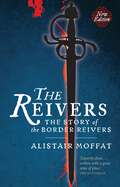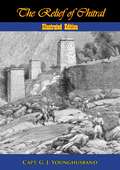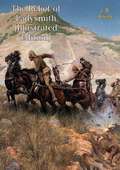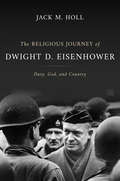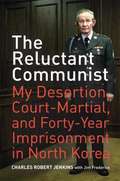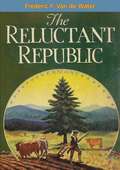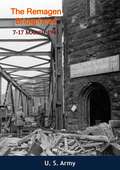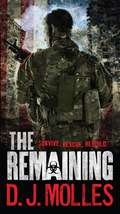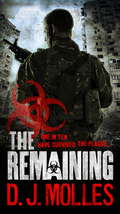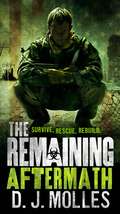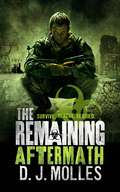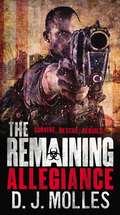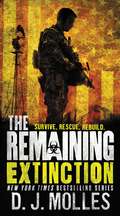- Table View
- List View
The Regency: The Morland Dynasty, Book 13 (Morland Dynasty #13)
by Cynthia Harrod-Eagles1807: the Napoleonic Wars continue and their violence reverberates in the lives of the Morland family.Lucy trying to rebuild her life after the death of her lover, Captain Weston, is thrown into doubt and confusion by an unexpected proposal of marriage. At Morland Place, the hard-won happiness of James and Heloise is threatened by his rebellious daughter, Fanny. As heiress to the Morland estate, Fanny is determined to claim more than her inheritance, but for those dependent on her generosity, Fanny's decision to marry the unscrupulous Lieutenant Hawker brings only anxiety.These troubled times hold many surprises, and in their darkest hour the Morlands make an astonishing discovery which enables them to face the uncertain future with new strength.
The Regiment
by Farley Mowat Lee WindsorThe story of an astonishing band of Canadian soldiers and their part in the Allied victory in Italy. The Hastings and Prince Edward Regiment (the Hasty Ps) was Canada’s most decorated regiment in the Second World War, winning thirty-one battle honours. Famed for their role in the Allied invasion of Sicily and the conquest of Italy, for six years the members of the regiment suffered brutal conditions, fighting bravely in the face of fierce opposition from the enemy, and ultimately triumphing. In The Regiment (originally published in 1955), Farley Mowat, famed Canadian fiction writer and regiment member, tells the story of the Hasty Ps, from their recruitment in September 1939 until the end of the war. Mowat was a second lieutenant and platoon leader with the regiment, and writes movingly of the great suffering his fellow soldiers endured, their bravery in battle, and the lasting friendships he forged as a member of the group.
The Regiment: 15 Years in the SAS
by Rusty FirminThis is the unforgettable chronicle of Rusty's combat experiences, transporting the reader back to the cutting edge of the SAS's deadly covert missions during the crises of the 80s and 90s. But even more fascinating is his intimate portrayal of what the service was actually like to live and work in. Having served as a paramedic, a demolitions expert, a linguist and ultimately the senior SAS bodyguard instructor, Rusty draws on a unique breadth of experience to delve into the hidden world of the SAS as an institution.From its early beginnings in World War II, the Special Air Service (SAS) has won renown in some of the most dramatic, dangerous and controversial military special operations of the 20th century. It is a secretive and mysterious unit, whose operations and internal structures are hidden from the public eye. Now, one of its longest-serving veterans offers a glimpse into the shadowy world of the SAS. Rusty Firmin spent an incredible 15 years with 'The Regiment' and was a key figure in the assault on the Iranian Embassy in London in May 1980, the near-suicidal planned attack on Argentina (operation MIKADO) during the Falklands war and the secret conflict between the SAS and the IRA in the 80s.
The Regiment: The Definitive Story of the SAS
by Michael AsherFrom the bestselling author of The Real Bravo Two Zero comes the definitive history of the world's most elite fighting force - the SAS'Breathtaking bravery, astonishing feats of endurance, raids and battles described with terrific immediacy and pace. Compelling and definitive . . . will surely not be bettered' Sunday TelegraphOn 4 May 1980, seven terrorists holding twenty-one people captive in the Iranian Embassy in London's Prince's Gate, executed their first hostage. They threatened to kill another hostage every thirty minutes until their demands were met. Minutes later, armed men in black overalls and balaclavas shimmied down the roof on ropes and burst in through windows and doors. In seconds all but one of the terrorists had been shot dead, the other captured.For most people, this was their first acquaintance with a unit that was soon to become the ideal of modern military excellence - the Special Air Service regiment. Few realized that the SAS had been in existence for almost forty years, playing a discreet, if not secret, role almost everywhere Britain had fought since World War II, and had been the prototype of all modern special forces units throughout the world.In The Regiment, Michael Asher - a former soldier in 23 SAS Regiment - examines the evolution of the special forces idea and investigates the real story behind the greatest military legend of the late twentieth century.'Detailed, scathingly honest. Asher has brought the critical eye of the knowledgeable insider to his in-depth study of SAS operations and personalities' HeraldPraise for Michael Asher: 'This is the most complete picture of the Sudanese campaigns that has yet been published . . . a vigorous and engrossing narrative' Philip Ziegler, Daily Telegraph'A staggering achievement. Asher has delivered a scintillating tale of a period of history that deserves to be remembered' Guardian
The Regionalization of Warfare: The Falkland/Malvinas Islands, Lebanon, and the Iran-Iraq Conflict
by James Brown William P. SnyderThree wars have dominated world events in recent years: The conflict which erupted between the United Kingdom and Argentina over the Falkland/Malvinas Islands; the multinational conflict in Lebanon involving Irsaeli, Syrian, and FLO forces in Lebanon; and the savage struggles between ground and air units of the Iranian and Iraqi forces. The scale and intensity of these wars, their potential for global conflict, make them crucial for an understanding among citizens in general, and defense and political analysts in particular.The authors and contributors to this most unusual volume come to several common conclusions: professionalism is a crucial factor in military effectiveness, but not necessarily dependent on modes of recruitment; high technology is crucial, but only in relation to the quality and training of the personnel; public support is necessary to sustain military morale in democratic and authoritarian regimes alike. These are only some of the incisive findings registered and explored in The Regionalization of Warfare.The volume a'ssembles experts not only on these three major regional and interregional conflicts, but on current U.S. defense policies; Soviet strategic interests in Middle East and Persian Gulf conflicts; and a series of papers on lessons learned and unlearned as a result of these "small wars" of the early 1980s. For those interested in military history, global strategy, and regional rivalries, this -collection of finely written, sophisticated papers will prove to be of intense concern.
The Regulars: The American Army, 1898-1941 (Studies In War, Society, And The Military Ser.)
by Edward M. CoffmanIn 1898 the American Regular Army was a small frontier constabulary engaged in skirmishes with Indians and protesting workers. Forty-three years later, in 1941, it was a large modern army ready to wage global war against the Germans and the Japanese. In this definitive social history of America's standing army, military historian Edward Coffman tells how that critical transformation was accomplished. Coffman has spent years immersed in the official records, personal papers, memoirs, and biographies of regular army men, including such famous leaders as George Marshall, George Patton, and Douglas MacArthur. He weaves their stories, and those of others he has interviewed, into the story of an army which grew from a small community of posts in China and the Philippines to a highly effective mechanized ground and air force. During these years, the U.S. Army conquered and controlled a colonial empire, military staff lived in exotic locales with their families, and soldiers engaged in combat in Cuba and the Pacific. In the twentieth century, the United States entered into alliances to fight the German army in World War I, and then again to meet the challenge of the Axis Powers in World War II. Coffman explains how a managerial revolution in the early 1900s provided the organizational framework and educational foundation for change, and how the combination of inspired leadership, technological advances, and a supportive society made it successful. In a stirring account of all aspects of garrison life, including race relations, we meet the men and women who helped reconfigure America's frontier army into a modern global force.
The Reich Intruders: RAF Light Bomber Raids in World War II
by Martin W. Bowman&“One of Britain&’s best-known aviation historians . . . provide[s] a moving and exciting account of the light bombers raids by No. 2 Group.&”—Firetrench This is the story of 2 Group RAF during World War II. Much of it is told by the men who flew the Blenheim, Boston, Mitchell and Mosquito aircraft that carried out many daring daylight and night-time raids on vitally important targets in Nazi occupied Europe and Germany. These were not the famous thousand bomber raids that hit the wartime headlines, but low-level, fast-moving surprise raids flown by small formations of fleet-footed and skillfully piloted twin-engine light bombers. Their targets were usually difficult to locate and heavily defended because of their strategic importance to the Nazis. 2 Group also played a vital part in the invasion of Europe both before and after D-Day. Often they would fly at wave-top height across the English Channel or North Sea to avoid detection and then hedge-hop deep into enemy territory to deliver their precision attack. Enemy fighters and anti-aircraft fire were a constant risk. This is a remarkable story of skill and bravery by a little-known branch of the RAF. &“The most known modern air war historian . . . has made his usual traditionally meticulous and well-researched work. Through combination of first-hand accounts and document sources he describes the exploits of British, Commonwealth and Allied twin-engine bomber crews who fought and won their own war in Europe&’s sky bravely and regardless its cost.&”—Mykhaylo Akimov &“If you are interested in British aviation history, then this book would make a good addition to any collection.&”—Armorama
The Reich Wreckers: An Analysis Of The 306th Bomb Group During World War II
by Major Charles J. Westgate IIIThis paper presents an analysis of the 306th Bomb Group's contributions during World War II. Rather than providing a simple recounting of the various dates and accomplishments, the paper analyzes some of the key indicators and statistics of the group's performance. In particular, the paper focuses on comparing aircraft losses and bombing results of the 306th with the Eighth Air Force's. The analysis also examined other areas, such as: mission aborts, enemy aircraft claimed destroyed, weather conditions over target, bombing methods used, presence of fighter escorts, and strength of enemy air defenses (enemy fighter aircraft and flak). The purpose of the analysis was to gain a better understanding of the group's overall performance within the bigger scope of the Eighth Air Force's war effort.The analysis was conducted in three steps. First, the archives of the Air Force Historical Research Agency (AFHRA) were searched for statistics on the 306th. Next, similar statistics were collected for the Eighth Air Force. Finally, the data for the two units was analyzed and compared, to aid in determining conclusions. To facilitate the last step of the research, the air war was divided into four periods. The goals and objectives for each period were used as criteria to grade the unit's effectiveness.In general, the study concluded that the 306th Bomb Group was a "typical" B-17 bomber group in World War II. When comparing the various statistics and graphs provide in this paper, we see that in most cases there was little difference in the data for the 306th and the Eighth Air Force. However, the statistics do not tell the whole story. As one of the cadre groups of the Eighth Air Force, many of the improvements and lessons learned during the early period of the war were at the expense of the 306th. These early lessons and experiments were important and led to the improvements that saved many lives and brought an end to the war.
The Reichsbank Robbery
by Colin Roderick FultonHistorical fact meets heart-stopping action in a World War II thriller full of &“intrigue and fast paced action . . . sure to appeal to fans of wartime fiction&” (Heritage and History). In February 1945, the US Air Force launched the largest daytime bombing offensive against Berlin, dropping over 2,250 tons of bombs on the German capital. Germany&’s state bank—the Reichsbank—received twenty-one direct hits, leaving the building badly damaged and the priceless contents of its vaults at risk. It was just the chance SS accountant Maj. Friedrich Schonewille was waiting for . . . Having never believed in the Fuhrer or the Reich, Schonewille is a man out for himself. Recruiting his own father, brother, and his secret Jewish wife, he concocts a plan to get rich as his homeland falls. First, they&’ll have to get the goods. Then, they&’ll have to stay ahead of the Nazis. Then, they&’ll have to keep from getting captured by either the Allies or Russians. And then all they have to do is not turn on each other . . . In this breakneck, &“visually evocative novel&” Colin Roderick Fulton imagines a scenario that could have easily happened in the dying days of the war (The Historical Novels Review).
The Reichstag Fire: The Case Against the Nazi Conspiracy
by Sven Felix KellerhoffWhen the German Reichstag went up in flames on the evening of 27 February 1933, Hitler used the incident to seize power, claiming it was the work of Communists planning a violent uprising. But who really started the fire? Were the Nazis to blame, or was it the work of lone arsonist Marinus van der Lubbe? This debate has been raging for more than eighty years. The Reichstag Fire seeks to shed light on this pivotal event that changed the course of world history. Through a thorough and unbiased analysis of original source material, award-winning journalist Sven Felix Kellerhoff charts the outbreak of the fire, the Reich Cabinet's response to the event, Marinus van der Lubbe's repeated confession to the crime, and the far-reaching consequences of the fire.
The Reign of Emperor Antoninus Pius, AD 138–161
by John S. McHughThe reign of Antoninus Pius is widely seen as the apogee of the Roman Empire yet, due to gaps in the historical sources, his reign has been overlooked by modern historians. He is considered one of the five good emperors of the Antonine dynasty under whom the pax Romana enabled the empire to prosper, trade to flourish and culture to thrive. His reign is considered a Golden Age but this was partly an image created by imperial propaganda. There were serious conflicts in North Africa and Dacia, as well as a major revolt in Britain. On his death the empire stood on the cusp of the catastrophic invasions and rebellions that marked the reign of his successor Marcus Aurelius. Antoninus Pius became emperor through the hand of fate, being adopted by Hadrian only after the death of his intended heir, Lucius Aelius Caesar. His rule was a balancing act between securing his own safety, securing the succession of his adopted heir and denying opportunities for conspiracy and rebellion. ‘Equanimity’ was the last password he issued to his guards as he lay on his death bed. In the face of the threats and challenges he remained calm and composed, providing twenty-three years of stability; a calm before the storms that gathered both within and beyond Rome’s borders.
The Reign of Emperor Gallienus: The Apogee of Roman Cavalry
by Ilkka Syvänne&“An unusual history of an unusual soldier of Rome who rose to Emperor . . . an engaging history of a fascinating subject—Very Highly Recommended.&” —Firetrench This is the only fully illustrated military life of the Emperor Publius Licinius Egnatius Gallienus (253-268). Considered the most blatantly military man of all of the soldier emperors of the third century, Gallienus is the emperor in Harry Sidebottom&’s bestselling Warrior of Rome novels. Gallienus faced more simultaneous usurpations and foreign invasions than any other emperor, but somehow he managed to survive. Dr. Ilkka Syvanne explains how this was possible. It was largely thanks to the untiring efforts of Gallienus that the Roman Empire survived for another 1,200 years. Gallienus was a notorious libertarian, womanizer, and cross-dresser, but he was also a fearless warrior, duelist and general all at the same time. This monograph explains why he was loved by the soldiers, yet so intensely hated by some officers that they killed him in a conspiracy. The year 2018 was the 1,800th anniversary of Gallienus&’ date of birth and the 1,750th anniversary of his date of death. The Reign of Gallienus celebrates the life and times of this great man. &“A beautiful book that investigates the life and works of an emperor undervalued by the &‘general public&’ but who deserves to be known for his military and historical legacy.&” —Old Barbed Wire Blog
The Reivers: The Story of the Border Reivers
by Alistair MoffatAn &“exciting and dramatic&” history of the raiders who ruled the lawless Anglo-Scottish borderlands for over a century (Cumberland News). Nowhere else in Britain in the modern era, or indeed in Europe, did civil order break down over such a wide area, or for such a long time, as on the border country between Scotland and England. For more than a century, the hoofbeats of countless raiding parties drummed over the border. From Dumfriesshire to the high wastes of East Cumbria, from Roxburghshire to Redesdale, from the lonely valley of Liddesdale to the fortress city of Carlisle, swords and spears spoke while the law remained silent. Fierce family loyalty counted for everything, while the rules of nationality counted for nothing. The whole range of the Cheviot Hills, its watershed ridges and the river valleys that flowed out of them, became the landscape of larceny while Maxwells, Grahams, Fenwicks, Carletons, Armstrongs, and Elliots rode hard and often for plunder. These were the Riding Times and in modern European history, they have no parallel. This book tells the remarkable story of the Reivers and how they made the Borders.
The Relief of Chitral [Illustrated Edition]
by Capt. G. J. Younghusband Capt. Sir Francis E. YounghusbandIncludes over 15 illustrations including detailed map of the area of operations.The Chitral Expedition was a military expedition in 1895 sent by the British authorities to relieve the fort at Chitral which was under siege after a local coup. After the death of the old ruler power changed hands several times. An intervening British force of about 400 men was besieged in the fort until it was relieved by two expeditions, a small one from Gilgit and a large one from Peshawar."To all who can enjoy military history this will be a fascinating book. It is written in conjunction by Captain F. E. Younghusband, formerly political officer at Chitral, and during the campaign correspondent of the Times, and his brother, Captain G. J. Younghusband, of the Guides who was with his regiment in General Low's force through the whole affair. Its information is therefore all firsthand, and as it is charmingly written, even the ordinary reader, while anathematising a few sentences of detail only interesting to soldiers, will find himself unable to lay it down. The cause of the war, the arrest of Captain Ross, the advance of General Low, Colonel Kelly's rush, the defence of Chitral, and the relief of Chitral, are all described with a lucid brevity and clearness which never fatigue. It was a wonderful little campaign; but to our minds the most interesting part of the book is the incidental proof it contains, that in spite of the success of Colonel Kelly's small force, the military authorities were in the right in their careful preparations."-The Spectator.
The Relief of Ladysmith [Illustrated Edition]
by J. B. AtkinsIncludes Boer War Illustrations Pack with 300 maps, plans, and photos.The Relief of Ladysmith is a detailed account of the siege of Ladysmith during the South African War (1899-1902) and the efforts to lift the siege and rescue the town's inhabitants. Atkins, a British officer who participated in the relief, provides a firsthand perspective on one of the most dramatic episodes of the war.—Print Ed.
The Religious Journey of Dwight D. Eisenhower: Duty, God, and Country (Library of Religious Biography (LRB))
by Jack M. Holl&“Our form of government has no sense unless it is founded in a deeply felt religious faith, and I don&’t care what it is. With us, of course, it is the Judeo-Christian concept, but it must be a religion that all men are created equal.&” So said Dwight D. Eisenhower shortly after being elected president of the United States in 1952. Although this statement has been variously interpreted, it reflects one of his fundamental guiding principles: that for a country to thrive, it needs a shared identity, formed through common values, history, and purpose. For Eisenhower, this could be found most distinctly in shared faith—a concept that came to be known as American civil religion, which defined and drove much of the cohesion of the 1950s under Eisenhower&’s leadership. This biography tells the story of how deeply religious convictions ran through every aspect of Eisenhower&’s public life: his decision to become a soldier, his crusade against fascism and communism, his response to the civil rights movement, his belief that only he as president could lead America through the Cold War, and his search for nuclear peace. Having been brought up in a devout family—first as part of the River Brethren and later Jehovah&’s Witnesses—Eisenhower continued to see the world in terms of a dialectical struggle between divine and demonic forces throughout his life, even after joining the Presbyterian church. This perspective shaped his public image as a general in World War II and as president during some of the coldest years of the Cold War, when cultural differences between the atheistic Soviet Union and the religiously grounded United States began crystallizing. As Eisenhower&’s historical standing continues to rise, and his contrast with the modern Republican Party deepens, Jack Holl&’s study of this consequential figure of twentieth-century American history shines a spotlight on what has changed in the intervening years. What can be learned from the religious outlook of a public servant who embraced moderation instead of partisan division? Which beliefs and convictions led a former general to a position of skepticism against the military-industrial complex? With the role of faith in American political life still a hotly debated topic today, Eisenhower&’s religious journey is worth renewed attention.
The Reluctant Communist: My Desertion, Court-Martial, and Forty-Year Imprisonment in North Korea
by Charles Robert JenkinsThis book will take the reader behind the North Korean curtain and reveals the inner workings of its isolated society while offering a powerful testament to the human spirit.
The Reluctant Republic: Vermont 1724-1791
by Frederic F. Van de WaterHistory of Vermont, as a republic separate from New York colony, as an independent state from the beginning of the United States. By the author of multiple historical fictions set in Vermont.—Print ed.
The Remagen Bridgehead, 7-17 March 1945
by U. S. ArmyThe purpose of this study is to collect all available facts pertinent to the Remagen Bridgehead Operation, to collate these data in cases of conflicting reports, and to present the processed material in such a form that it may be efficiently utilized by an instructor in preparing a period of instruction.The data on which this study is based was obtained from interviews with personnel who took part in the operation and from after action reports listed in the bibliography. This is an Armored School publication and is not the official Department of the Army history of the Remagen Operation. It must be remembered that the Remagen Operation is an example of a rapid and successful exploitation of an unexpected fortune of war. As such, the inevitable confusion of facts and the normal fog of war are more prevalent than usual. The absence of specific, detailed prior plans, the frequent changes of command, and the initial lack of an integrated force all make the details of the operation most difficult to evaluate and the motives of some decisions rather obscure.The operation started as a two-battalion action and grew into a four-division operation within a week. Units were initially employed in the bridgehead, as they became available, where they were most needed: a line of action that frequently broke up regiments. In cases of conflicting accounts of the action, the authors of this study have checked each action and each time of action included in the study and have evaluated the various reports in order to arrive at the most probable conclusions.
The Remaining (The Remaining #1)
by D. J. MollesThe first volume in D.J. Molles's bestselling series, now in a special edition with the bonus novella The Remaining: Faith. In a steel-and-lead encased bunker a Special Forces soldier wait on his final orders. On the surface a bacterium has turned 90% of the population into hyper-aggressive predators. Now Captain Lee Harden must leave the bunker and venture into the wasteland to rekindle a shattered America. This is the first novel D.J. Molles's bestselling series: Book 1: The Remaining Book 2: The Remaining: Aftermath Book 3: The Remaining: Refugees Book 4: The Remaining: Fractured Novella 1: The Remaining: Trust Novella 2: The Remaining: Faith
The Remaining (The Remaining #1)
by D. J. MollesA SOLDIER'S MISSION IN A RAVAGED WORLD: SURVIVE, RESCUE REBUILD.In a steel-and-lead-encased bunker twenty feet below gorund, a soldier waits for his final orders. On the surface, a bacterium has turned over 90% of the population into hyper-aggressive predators, with an insatiable desire to kill and feed. But now the day has come when he must open the hatch to his bunker, and step out into the chaos . . .The first volume in D.J. Molles's bestselling series, now in a special edition with the bonus novella The Remaining: Faith.
The Remaining: Aftermath (The Remaining #2)
by D. J. MollesTo Captain Lee Harden, the mission to rescue his countrymen and rebuild the nation seems like a distant memory. Wounded and weaponless, he has stumbled upon a group of survivors who may be his last hope. But a tragedy in the group causes a deep rift and forces him into action. And in the chaos of a world overrun by infected, Lee is pursued by a new threat: someone who will stop at nothing to keep him from his sworn duty.This is the second novel D.J. Molles's bestselling series:Book 1: The RemainingBook 2: The Remaining: AftermathBook 3: The Remaining: RefugeesBook 4: The Remaining: FracturedNovella 1: The Remaining: TrustNovella 2: The Remaining: Faith
The Remaining: Aftermath (The Remaining #2)
by D. J. MollesA SOLDIER'S MISSION IN A WORLD GONE TO HELL: SURVIVE, RESCUE, REBUILDNothing has gone according to plan.To Captain Lee Harden, Project Hometown feels like a distant dream and the completion of his mission seems unattainable.Wounded and weaponless, he has stumbled upon a group of survivors that seems willing to help. But a tragedy in the group causes a deep rift to come to light and forces him into action. In the chaos of the world outside, Lee is pursued by a new threat: someone who will stop at nothing to get what he has.This is the second book in the bestselling Remaining series, telling a gritty tale of survival, perseverance and fighting to get back what has been lost.
The Remaining: Allegiance (The Remaining #5)
by D. J. MollesThis is the fifth, never-before-published, novel in the action-packed series following Special Forces Captain Lee Harden and a group of survivors struggling to survive while rebuilding an America devastated by a bacterium that has turned 90% of the population into a ravenous horde. Through an overwhelming storm of pain and adversity Captain Lee Harden has fought and survived. But his mission continues. Recovering from his wounds, mental and physical, he must rally his companions at Camp Ryder and push back against the still swarming hordes of the infected that threaten to extinguish an already devastated society. Book 1: The Remaining Book 2: The Remaining: Aftermath Book 3: The Remaining: Refugees Book 4: The Remaining: Fractured Book 5: The Remaining: Allegiance Book 6: The Remaining: Extinction Novella 1: The Remaining: Trust Novella 2: The Remaining: Faith
The Remaining: Extinction (The Remaining #6)
by D. J. MollesThis is the sixth and final novel in the action-packed series following Special Forces Captain Lee Harden and a group of survivors struggling to survive while rebuilding an America devastated by a bacterium that has turned 90% of the population into a ravenous horde. The merciless tide of infected is flooding south and time is running out to stop them. Bolstered by new allies, Captain Lee Harden continues his struggle to establish a safe haven from which the embers of a shattered society can be rekindled. This is the sixth and final novel in D.J. Molles's bestselling series: Book 1: The Remaining Book 2: The Remaining: Aftermath Book 3: The Remaining: Refugees Book 4: The Remaining: Fractured Book 5: The Remaining: Allegiance Book 6: The Remaining: Extinction Novella 1: The Remaining: Trust Novella 2: The Remaining: Faith

